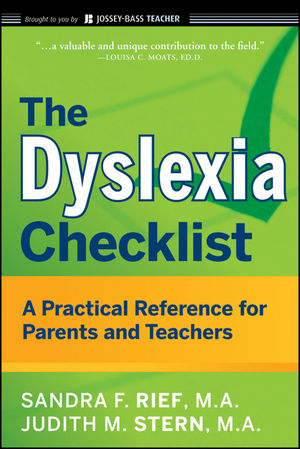The Dyslexia Checklist: A Practical Reference for Parents and TeachersISBN: 978-0-470-42981-5
Paperback
336 pages
January 2010, Jossey-Bass
 |
||||||
About the Authors.
Introduction.
1. Basic information on dyslexia.
Introduction.
1.1. Clarifying the Terms Dyslexia and Learning Disabilities.
1.2. Important Facts and General Information About Dyslexia.
1.3. Signs and Symptoms of Dyslexia.
1.4. Decades of Research: What We Now Know About Dyslexia.
1.5. Other Common Problems.
1.6. Common Strengths and Positive Characteristics of People with Dyslexia.
1.7. Diagnosing Dyslexia.
1.8. Research-Based Intervention Programs for Struggling Readers.
1.9. What Children with Dyslexia Need from Parents and Teachers.
1.10. Key Instructional Components and Interventions for Students with Dyslexia.
1.11. Dual or Multiple Exceptionalities (Gifted and Dyslexic).
Resources.
2. Strategies for helping with reading, language, and writing.
Introduction.
2.1. Phonological Awareness.
2.2. Systematic Phonics.
2.3. Decoding Strategies.
2.4. Sight Word and Irregular Word Strategies.
2.5. Fluency Strategies.
2.6. Vocabulary Strategies.
2.7. Comprehension Strategies.
2.8. Spelling.
2.9. Common Writing Diffi culties for Children with Dyslexia.
2.10. Strategies to Help with Prewriting: Planning and Organizing.
2.11. Strategies for Teaching Composition and Written Expression.
2.12. Strategies to Help with Revising and Editing.
2.13. Assistive Technology to Support Reading and Writing.
2.14. Accommodating Reading and Writing Difficulties.
2.15. Games and Activities to Strengthen Literacy and Language Skills.
2.16. The Basic Spelling Vocabulary List.
Resources.
3. Checklists for parents.
Introduction.
3.1. Talking with Your Child About Dyslexia and Other Learning Differences.
3.2. How to Advocate for Your Child.
3.3. Finding a Tutor or Educational Therapist.
3.4. Building and Nurturing Your Child’s Self-Esteem.
3.5. How to Help Your Child with Homework.
3.6. Reinforcing Reading Skills at Home.
3.7. Helping Your Child with Organization and Time Management.
3.8. Strategies for Building Your Child’s Study Skills.
Resources.
4. Checklists for teachers.
Introduction.
4.1. Adaptations, Accommodations, and Modifi cations: What’s the Difference?
4.2. How Teachers Can Help Students with Homework.
4.3. Differentiating Instruction.
4.4. Adaptations and Modifi cations of Materials.
4.5. Adaptations and Accommodations in Testing.
4.6. Helping Students with Organization and Time Management.
4.7. Strategies to Aid Memory.
4.8. Strategies for Teaching Reading in the Content Areas.
Resources.
5. Other important checklists for parents and teachers.
Introduction.
5.1. High School Students with Dyslexia.
5.2. College Students with Dyslexia.
5.3. Response to Intervention.
5.4. Special Education.
5.5. Individualized Education Plans.
5.6. Section 504.
5.7 National Organizations and Resources That Address Disability Issues.
Resources.
Index.



